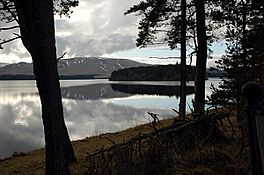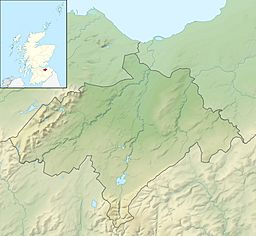Gladhouse Reservoir facts for kids
Quick facts for kids Gladhouse Reservoir |
|
|---|---|
 |
|
| Location | Midlothian |
| Coordinates | 55°46′10″N 3°07′11″W / 55.7695°N 3.1198°W |
| Type | reservoir |
| Basin countries | Scotland |
| Surface area | 460 acres (190 ha) |
| Islands | 3 |
| Designated: | 14 July 1988 |
| Reference #: | 404 |
Gladhouse Reservoir is a large reservoir in Midlothian, Scotland. It is about five miles (8 km) south of Penicuik. This reservoir was once known as Moorfoot Loch.
Gladhouse Reservoir is the biggest area of freshwater in the Lothians region. It is also the most southerly reservoir in Midlothian. The water from this reservoir helps supply Edinburgh with drinking water.
Contents
Building the Reservoir
Gladhouse Reservoir was built in 1879. An engineer named James Leslie designed it. It is the oldest reservoir in the area that feeds into the River South Esk.
The reservoir was created to give more drinking water to Edinburgh. The older, smaller reservoirs in the Pentland Hills could not provide enough water for the city's needs anymore.
About Gladhouse Reservoir
Gladhouse Reservoir covers a huge area of 186 hectares (460 acres). This makes it the largest freshwater area in the Lothians. It is a big, but not very deep, body of water.
The reservoir has two small islands. It sits about 270 meters (886 feet) above sea level at the bottom of the Moorfoot Hills. The dam and other structures were built using pink sandstone.
When it was built, the reservoir was designed to hold up to 1,700 million gallons of water. This was seen as a great engineering achievement at the time. By building this reservoir and damming the River South Esk, Edinburgh got an extra 180 liters (40 imperial gallons) of water per person.
Fishing at the Reservoir
Gladhouse Reservoir is a popular spot for fishing. It is stocked with brown trout, which means new fish are regularly added for anglers to catch.
Wildlife and Birds
Gladhouse Reservoir is a very important place for birds. Many birds come here, especially in winter. It is a key resting place for large groups of pink-footed geese. There are also many greylag geese living here.
Because of the huge number of pink-footed geese, Gladhouse Reservoir has been named a Ramsar site. This means it is recognized as an internationally important wetland.
Other birds that have nested and raised their young here include mallards, tufted ducks, teal, coots, moorhens, great crested grebes, and little grebes. In winter, you can also see many mallards, teal, wigeon, and tufted ducks.
Images for kids
See also
 In Spanish: Embalse de Gladhouse para niños
In Spanish: Embalse de Gladhouse para niños



